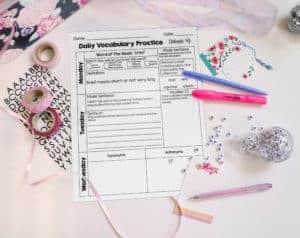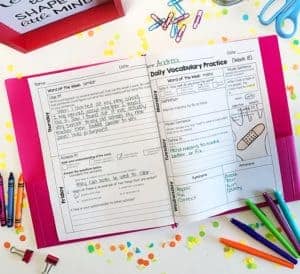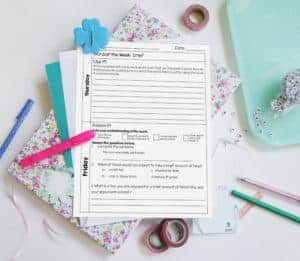Academic language & the benefits of Daily Academic Vocabulary
Daily Academic Vocabulary is designed to support students to build the academic language skills needed to be successful in school. While many students have a strong conversational vocabulary, they lack the exposure and understanding of the Tier 2 words commonly used in the classroom and on standardized assessments.
While this is common, and often addressed, for students identified as English Language Learners (ELL), there are many non-ESL students who face the same language struggles as their peers learning English.
What is academic vocabulary?
Academic vocabulary is the term for the language students hear in school that is uncommon in their everyday conversations. It is, at its core, the language of school. Academic vocabulary words are the terms students must know to comprehend assignments and directions in class.
While some may suggest that this is “testing vocabulary”, the language of standardized testing is just one piece of academic language. The vocabulary of standardized assessments is comprised of verbs and nouns that push students to dig deeper into the subjects of their learning. Words like analyze and outline are examples.
Identified in the standards as Tier 2 and Tier 3 words, developing academic language is an important piece of understanding and performing well in school. Being able to quickly recall academic vocabulary definitions can help students better comprehend discussions, assessments, and assignments.
What’s the difference between Tier 2 and Tier 3 vocabulary?
Tier 2 vocabulary are the general academic words that apply across all subjects, while Tier 3 words are specific vocabulary aligned to a specific area of study. For example, physical properties is a Tier 3 academic vocabulary term a student would need to be familiar with in science. However, generate is a Tier 2 word that students may see in many different subject areas.
How does academic vocabulary fit with the standards?
The Common Core State Standards include the important academic vocabulary students must know by grade level within the standards. This is also true of other state standard systems, where the important verbs and nouns of academic language are clearly identified within each standard to help teachers identify exactly what students must be know and be able to do.
Why do we need to teach academic language?
While having a definition of academic vocabulary is helpful, it is important to understand why we must teach academic vocabulary.
All students, but especially those that struggle academically, need explicit direct instruction in academic vocabulary. This helps students learn to navigate and succeed in school by providing them with a foundation to build their subject-level understanding.
Breaking down these words and helping students build them into their own vocabulary is crucial for long-term academic success.
What is Daily Academic Vocabulary?
After working with numerous students where academic vocabulary was their main barrier to school success, I decided to study strategies for teaching vocabulary and developed Daily Academic Vocabulary as a result of what I learned.
Daily Academic Vocabulary is 36-week vocabulary program with daily activities that focus on deeply studying one grade-level appropriate, commonly utilized word per week.
Students begin the week with activities to increase exposure and explore the word’s meaning, and as the week continues, they transition to higher-level tasks including analysis and application.

Designed to be used as a short warm-up or culminating activity, the daily tasks focus require students to spend no more than 10 minutes per day working with the word of the week. However, that time is purposefully designed to build a deep, rich understanding across the course of 5-days.
While this product can be used for targeted intervention or tutoring, it is also a great activity for whole class review and discussion.
What does a week of Daily Academic Vocabulary look like?
Like I mentioned above, the goal is to build a deep understanding and help students master the new word by the end of a week’s time. Therefore, each day focuses on building a different level of meaning. Here’s how the days are laid out.
Monday: Introduce & Explore
Monday is all about exposure and exploration. Students are introduced to their new word of the week and asked to rate their current understanding of the meaning. This helps get them thinking about the word and gives the teacher an easy way to gather a quick peek into student’s background knowledge.
The (kid-friendly) formal definition is also introduced giving opportunities for discussion.
A model sentence is provided and students are asked to use the model to help them identify the part of speech the word falls under. This will help guide their use of the word later, as they build a deeper understanding.
Tuesday: Visualize & Define

The second day focuses on developing a non-linguistic representation of the word, which has been identified by Marzano and colleagues as an important component of internalizing the meaning of new vocabulary.
Students sketch an illustration of the word or create a symbolic representation of it. This is a fun and engaging way to get kids thinking about the word in a new way.
They also craft their own definition of the term on this day.
When it comes to academic language, formal definitions can be wordy and don’t always mesh with student’s background knowledge. This personalized definition helps the student explore the meaning. It also gives you a chance to correct misconceptions before they become deeply embedded.
Wednesday: Synonyms & Antonyms
This day is all about connecting the new vocabulary to academic language the student already knows.
By creating a list of synonyms and antonyms related to the week’s word, students begin hooking this new vocabulary term to other words they already know well. Similar to comparing and contrasting, a known best practice for mastery, this process is great for moving beyond the basic understanding. It really helps students explore nuances of new academic vocabulary.
Thursday: Apply in Writing

By Thursday, students have a solid working knowledge of the word. Now it is time to move their work to the next level. The open-ended format provides freedom to connect to each child’s personal background experience.
Students are asked to write a short paragraph (or a sentence or two, for younger learners) that utilizes the word. The writing must clearly show an understanding of the definition.
This offers the teacher an opportunity to formatively assess student progress and provide support to clarify misconceptions.
The brevity of the task keeps students from feeling overwhelmed as they begin moving from a more verbally-focused use of the new word to using it in their writing.
Friday: Application in Context
Friday’s tasks continue to build on Thursday’s higher-level application. Initially, students are asked to re-rate their understanding of the word and its definition. However, the remaining time is spent applying their knowledge of the word to answer questions.
Both multiple-choice and short answer questions are included.
Students are exposed to the week’s word in context without the scaffolds provided earlier in the week. This simulates the way students might see these words in a classroom assignment or on standardized assessments. It also gives the teacher a good sense of where students are in terms of mastery.
What other tools are included?
There are two other core components to this program.
Progress Assessments
First is the quarterly assessment, which is designed to formally monitor retention of the previously taught vocabulary.
You’ll likely hear these terms incorporated into academic conversations and utilized on assignments. However, it is important to continue to monitor student’s understanding to ensure there isn’t confusion as new words are introduced.
These quarterly assessments are simple and easy to grade, with answer keys included. They provide a good look into who might need additional intervention supports for vocabulary. They also give data that can be provided to an RTI or MTSS team during a student data meeting.
Word Wall & Student Dictionary Cards
A set of vocabulary cards is provided for all words in the set. The cards have a simple design to prevent distraction. They are also blackline so they can be printed on colorful paper or cardstock, if desired. There are two sizes included in each set – large and small.
The large cards are great for word walls or pocket charts. The bold lettering can be easily seen and helps students when it comes to recalling and spelling the words.
The small set is ideal for creating vocabulary rings or student dictionaries. They can also be provided to parents as a way to help them review these words at home.
Why only one word per week?

The word-a-week format was specifically selected to help build a deep understanding of the meaning of the word and to give students time to incorporate that knowledge into their schema.
Many programs brag about their academic word lists and the number of new words covered each week. These programs take a great deal of time and just skim the surface of the new vocabulary.
Research shows short, focused practice actually leads to higher mastery rates. The 10-minute per day format with a singular word of the week lends itself to that perfectly.
Making the connections between the vocabulary they already know and the new word promotes mastery. It also helps students deepen their knowledge of the academic language they already know. Rather than build a surface level understanding of 5-10 new words, this program is designed so that once a word has been taught, students truly know and can use it.
Want to know more?
Want to know more about the research on academic vocabulary and student outcomes? Here’s an article that outlines the importance of academic vocabulary for students.
Wish you could try it out with your students?







